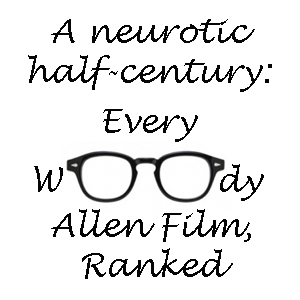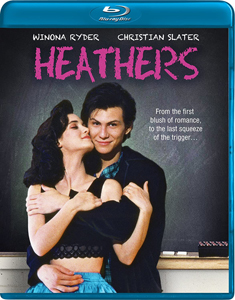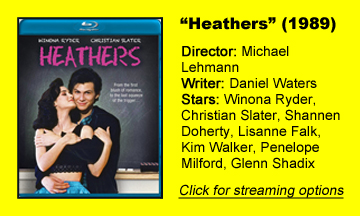“Heathers” (1989) is one of the most oft-referenced titles in teen-movie scholarship, and the film itself regularly gets referenced in other works. Namely, the term “Heather” now refers to a self-centered popular girl.
More subtly, Christian Slater became the go-to heartthrob of the 1990s – for example, the girls in the equally classic “Clueless” (1995) plan to attend the new Christian Slater movie.
Soapy staging, sloppy editing
Because it is so influential, it’s hard to write about “Heathers” and not make it sound like it’s a good, or at least groundbreaking, film. I’m not saying the people who love it are wrong; comedy is subjective, and this movie is filled with talking points. But I find it boring, with soap-opera staging and sloppy editing – but not in an artistic way where the commentary overcomes the flaws or makes them endearing.
Written by Daniel Waters (“Batman Returns”) and directed by Michael Lehmann (later a TV director for hire), “Heathers” is a dark comedy in tone but not in cleverness. Almost none of the humor lands.
The best gag is the funeral of football players Kurt (Lance Fenton) and Ram (Patrick Labyorteaux), wherein one of their dads bemoans that he loves his late son even though it turns out he was gay. This is darkly funny because the kid wasn’t really gay; he was a bully whose gayness is faked in a false suicide note by Slater’s J.D.
“Heathers” doesn’t take place in a realistic world; that’s not necessarily a flaw, since it is purposely satirizing high school life, or at least the broad strokes of high school life as portrayed in John Hughes films. But Lehmann doesn’t settle on an internal style, and that is a problem. The schlockiness comes off as incompetence, with every character’s actions coming from Waters’ whims.
A popular psychopath
Although it’s best known for the term “Heathers” and its portrayal of the dark side of popularity, the film is structured around J.D.’s proto-Patrick Bateman psychopathy and the gradual realization from Winona Ryder’s Veronica that dating him is not worth it.
Slater’s word-chewing performance is annoying, perhaps purposefully so, and there’s never much of a sense that J.D. and Veronica truly like each other. I also didn’t realize that J.D. was supposed to be the benchmark of coolness until Veronica’s diary entries say as much.
He’s an outsider in the lunchroom and he goes around in an “Angel”-esque duster, so it strikes me that he wouldn’t be Veronica’s ideal stepping stone toward the inner circle, especially in a tale that’s otherwise so clique-conscious.
Veronica supposedly feels bad about serving as J.D.’s partner in the staging of a string of false suicides, but how bad can she feel when she’s on hand for every “suicide?” The screenplay tells us she’s off-balance about all of this, but that makes her seem shallow and dumb.
Yet at other times, we’re told she is smart. Is this a running joke about how even the “smart” protagonist is an idiot? I almost think so – after all, Veronica bizarrely uses a monocle when writing in her diary – but the filmmaking is so rough overall that I can’t quite go there.

Why so many Heathers?
There’s no internal reason why three popular girls (Lisanne Falk, Kim Walker and “90210’s” Shannen Doherty) are named Heather. We could bring our own subtext, I suppose: Maybe it’s a commentary on the ubiquity of that name. But Heather wasn’t such a common name in 1989 to be worthy of a joke. (It was the 12th most popular girls’ name among 1971 babies.)
I find the “Lizzie McGuire” gag about the seven other kids named Matt in Matt’s class to be funnier. Nor does “Heather” function like “Chad” where the person grows into the name’s stereotype. Every real-life Heather I’ve met has been a quite nice person.
The Westerburg High School mascot is the Rottweilers – something that’s goofy but not all that amusing. Most of the background teens – including the aforementioned jocks – look 30, and I’m not sure if that’s a purposeful in-joke or not.
(There’s a stereotype that teen movies feature 30-something actors, yet there are so many that do not. Indeed, when “Heathers” came out, Ryder and Doherty were 17 and Slater was 19.)
Veronica’s parents are on a totally different wavelength from their daughter. When her mom (Jennifer Rhodes) finds that Veronica has supposedly hanged herself in her room, she immediately verbally regrets not allowing Veronica to get that job at the mall she wanted. This is such a surface-level screenplay.
A false anarchic tone
I guess “Heathers” is beloved because people hadn’t seen high school tropes treated with such an anarchic tone before, but I can’t get past the falseness.
Among tonally bizarre high school commentaries, I’d rather watch “Disturbing Behavior,” featuring Nick Stahl perhaps trying to channel Slater’s “Heathers” performance. Or “Teaching Mrs. Tingle,” where three teens plot a murder and run into darkly comedic troubles.
Admittedly, I’ve just cited two “Heather”-influenced films from a decade later, which — as a 1996 high school graduate — was more my era. So that takes a step toward answering why I missed the boat on “Heathers’ ” appeal.
That said, when viewed in a vacuum, I find “Heathers” unfocused and unpleasant. It’s horror-adjacent, comedy-adjacent and reality-adjacent. It’s not easily categorized. It’s “so very” unusual, and that makes it interesting to discuss – but not to watch.


